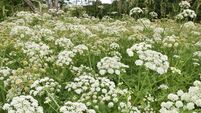Department hopes myxo threat to doesn't spread to Irish hares

Wildlife groups and the Department of Agriculture are hoping what appears to be a deadly form of myxomatosis in brown hares in Britain will not reach our shores.
Scientists have been receiving numerous reports of dead or dying hares in the east of England. It seems the deadly infection spread from rabbits, which were almost wiped out years ago following the introduction of the ‘myxo’ virus to Britain in the 1950s to control their population.
We have a small population of brown hares, confined mainly to pockets of Co Donegal and mid-Ulster, where it was introduced for hunting in the middle of the 19th century. On the other hand, the native Irish (mountain) hare is found in most parts of the country, even in golf clubs, but its numbers have fallen.
Scientists are keeping their fingers crossed that the Irish hare will not be hit by the virus and point out it is a different species to the bigger brown hare. However, department officials are calling for vigilance, and autopsies will be carried out where sick or dead hares are found. The highly infectious virus is spread by blood-sucking insects.
Anyone who has seen affected rabbits will know how distressing a sight that can be.
Diana Bell, a biologist at the University of East Anglia, says the disease has the potential to wipe out the hare population. And, though not yet absolutely confirmed, she believes there’s a spread of myxomatosis from rabbits to hares, judging from photographs she has seen.
Warnings have already been given about other threats to the native Irish hare from the European brown hare. Neil Reid of Queen’s University Belfast, who has been researching hares for many years, says the brown hare has been highly successful in invading many countries beyond its native range in southwest Europe and parts of Asia.
He says the brown hare is a strong competitor for habitat spaces and food with other hare species. Hybridisation, or cross-breeding, with the Irish hare is another significant concern.
The Irish hare has a unique ancestry, which is restricted to Ireland, where it has been for longer than many other animals, making it one of our few native mammal species, according to Dr Reid.
It has been isolated here for 30,000 to 60,000 years. So the discovery that both species are hybridising in the wild is very worrying.
Irish hare population numbers can vary widely, depending on issues such as competition for food with rabbits and the brown hare, spread of disease and changes in farming. Our native hare is protected under the Wildlife Act, but is also a game species that can be hunted under licence during the open season, or caught for muzzled coursing.













